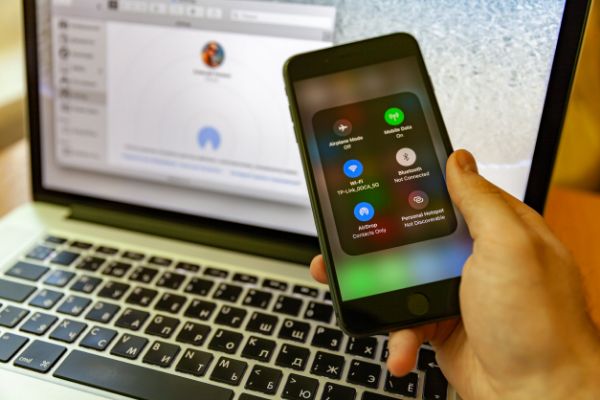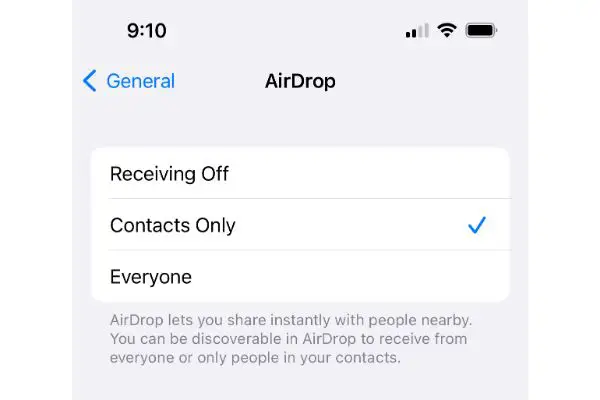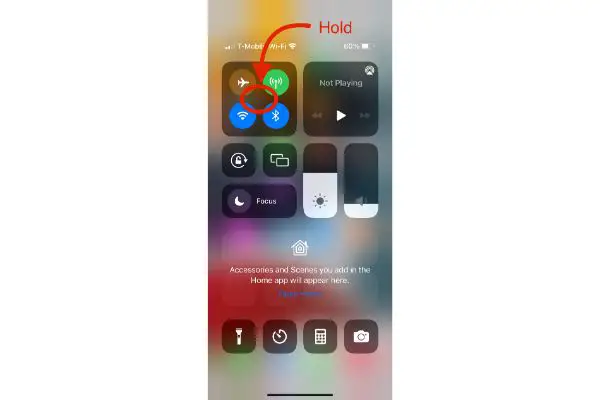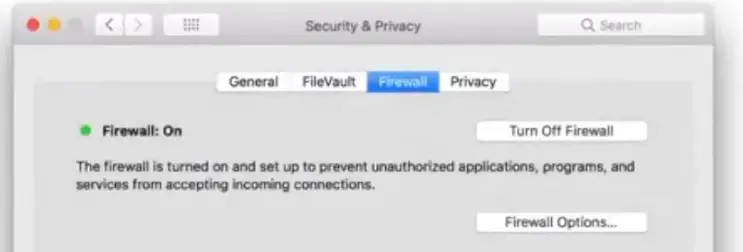Disclaimer: This post may contain affiliate links, meaning we get a small commission if you make a purchase through our links, at no cost to you. For more information, please visit our Disclaimer Page.
AirDrop is a great way to share files between friends or family members, or to transfer files when you don’t have access to Wi-Fi. It’s also useful for sending large files that wouldn’t normally fit in an email.
But what if you don’t have access to Wi-Fi and are out and about? Is it still possible to use AirDrop when you don’t have access to Wi-Fi?

(Attribution: ©ahilfoto/123RF.COM)
In this blog post, we will discuss how AirDrop works, and answer some common questions about it. We will also show you how to use AirDrop without Wi-Fi if needed.
Table of Contents
What is AirDrop and How Does it Work?
AirDrop is a feature on Apple devices that allows you to share files and photos with other Apple users without using data. AirDrop works by creating a temporary wireless network between the two devices, allowing them to share files.
When using AirDrop, the Apple device creates a peer-to-peer Wi-Fi network between the sender and receiver using Bluetooth. The two Apple devices work in tandem to build a secure firewall around them and encrypt all communications, making it impossible for the data to be hacked along the way.
You can share almost everything like photos, videos, documents, and even locations with AirDrop. It’s also a secure way to share sensitive information, as the data is encrypted during transmission.
Does Apple AirDrop Use Data?
AirDrop uses peer-to-peer Wi-Fi to send data. It does not use your cellular data plan.
The device uses Bluetooth to create a connection and then Wi-Fi to send the data. AirDrop does not use your cellular data plan, so it will not cost you anything extra to use it.
Actually, you don’t even need to be connected to an external Wi-Fi Network to be able to use AirDrop. All you need is to turn ON the Wi-Fi and Bluetooth on the devices you need to use AirDrop on.
Thus, we can safely conclude that Apple will not use the data allowance on your phone’s data plan.
Can You Receive Airdrops Without Wi-Fi?
Yes, you can receive Airdrops without Wi-Fi. All you need is to turn ON the Wi-Fi and Bluetooth on the devices you need to use Airdrop on. Your device will show a list of nearby AirDrop users who are sharing files.
Note that having the Wi-fi icon ON is not using a Wi-fi network, but instead it’s a Wi-Fi direct connect, also known as peer-to-peer Wi-Fi. You can read more about it here.
Select the file you want to receive, and it will be downloaded to your device. Even though you don’t need Wi-Fi to use AirDrop, both devices must be turned on and have both Bluetooth and Wi-Fi turned ON.
Does AirDrop Work Over Cellular?
No, AirDrop does not work over cellular. It uses peer-to-peer Wi-Fi to send data, so it does not use your cellular data plan.
You can use AirDrop without Wi-Fi if needed by turning on both the Wi-Fi icon and Bluetooth on your devices. However, both devices must be turned on and have both Bluetooth and Wi-Fi turned ON.
Peer-to-peer Wi-Fi works independently of cellular data networks, so you don’t need to worry about using up your data plan when using AirDrop.
Furthermore, you can share unlimited files of any size with Airdrop, since you are not using a chargeable bandwidth.
How to Get or Send AirDrop Without WI-FI? (iPhone & MacBook)
Since AirDrop uses peer-to-peer Wi-Fi to send data, you can use it without Wi-Fi as long as both devices have Bluetooth and Wi-Fi turned ON.
How do you Turn on AirDrop on iPhone & iPad?
To adjust Airdrop settings on your iPhone & iPad:
- Go to Settings app -> General -> AirDrop
- Now that you’re at the air drop screen, select ” Contacts Only”.
Another way you can edit the airdrop settings:
- On newer iPhones or iPad: Near the Wi-Fi and battery icons at the top righthand side, using your finger, slide down
- On Older iPhones with a home Button: From the bottom, you’ll need to slide up.
- Now at the top right, you’ll see airplane mode, personal hotspot, Wi-Fi and bluetooth. Tap and hold the center of these 4. It’ll expand to a bigger screen where you’ll see AirDrop. Now click on it and tap on “Contacts only”.
With either option, if you select “Everyone”, that means that anyone nearby can share or receive files from you. Do not select this if you are in a public area with strangers.
The option, “Receiving off”, turns off AirDrop.
To share files with AirDrop on your iPhone & iPad:
- Simply open the photos app and select the file you want to share.
- On the bottom left side, hit the icon that looks like a square with a up-arrow going through the top middle. That’s your share button.
- Now your sharing options will appear and one option you’ll see if AirDrop if you turned it on.
When selected, it’ll show a list of devices nearby to share. If someone is sending you a file through AirDrop, your phone will get a notification on the screen.
How Do You Turn On AirDrop on Mac?
- Click on the Finder Icon
- On the Left-hand side, go to AirDrop. Now that you’re on the Airdrop Screen, if you get the notification to turn on Wi-Fi and Bluetooth. Click on it and it’ll automatically turn both on.
- If you do not see the option to Turn On Wi-Fi and Bluetooth on the airdrop screen, there’s a way to manually turn those on. On the right side of your screen, you should see a bluetooth and Wi-fi icon. Click on both of them individually and make sure they are both turned on. A greyed out icon shows that the setting if off.
- If you do not see the Bluetooth Icon, click the search icon and search for “Blue Tooth File Exchange”. clicking that will give you the option to turn on Bluetooth.
- Now you should be able to use AirDrop!
To Share a Photo on Mac to Your iPhone or iPad
- Click the photo app at the bottom
- Select an image or highlight several
- Now, at the top of your screen, next to the search is the share icon. Click on that and you should see an option to use AirDrop to share your photos.
- An important thing to know is that you need to be logged into iPad or iPhone for AirDrop on your Mac to find the device.
If you have trouble setting up AirDrop, there are more tutorials on YouTube.
Can You Get AirDrop on Android?
The answer is no. You can’t get AirDrop on Android because the feature is only available on Apple devices.
If you want to transfer files between your Android device and an Apple device, you’ll need to use a third-party app like Send Anywhere or ShareIt.
Why Can’t My iPhone, iPad Or Mac Receive Airdrops? (7 Reasons)
There are some reasons your Apple devices might not be able to receive airdrops.
Your Devices are Out of Range
First, make sure that both your Apple devices you’re trying to send the AirDrop to are close enough together. Airdrops only work over short distances, so if you’re too far away, it won’t work.
You don’t have AirDrop Enabled
Check to see if you have enabled AirDrop in your iPhone, iPad or Mac settings. Above in the “How to Get or Send AirDrop Without WI-FI?” section will show you how.
Wi-fi & Bluetooth is Turned off
You have Wi-Fi and Bluetooth off. As mentioned earlier, you need both of these settings ON to use AirDrop on the devices you wish to transfer files.
Make sure your Devices are logged in
If you are sharing photos from a Mac, you need to make sure that the device you are shared is logged into.
So that means unlocking your iPhone or iPad. Doing this will have that device appear on your AirDrop menu on your Mac.
Download the Latest Version of iOS
Make sure that you have the latest version of iOS installed on your iPad, iPhone or Mac. If either one of the devices is not up to date, there may be issues when Airdropping.
iPhone & iPad: To check for updates, open the Settings menu and select “General.” Scroll down and select “Software Update.”
Mac: Go to the system icon below, click Software Update.
If there are any updates available, install them by following the on-screen instructions.
You have an Older Mac
This can be a common issue found in older Macs. Luckily, there’s an easy way for you to find that device.
On your newer MacBook, in the Airdrop Settings, you can select “Don’t see who you’re looking for”.
Once you select that, you’ll see an option for your new mac to search for an older Mac. After selecting that, it should appear shortly in the Airdrop of your newer Mac.
iMac Firewall Issue
This problem occurs when your iMac can Airdrop photos directly to your iPhone/iPad, but your iPhone/iPad cannot share photos to that iMac. There’s 2 fixes to this.
Method 1
To fix this, go to Settings -> Security & Privacy -> Turn off Firewall
Now that the firewall is turned off, wait till your iPhone recognizes this and it should appear on the Airdrop screen when you are clicking to share a photo.
Remember to turn the firewall back on when you are done AirDropping.
Although this is a way to fix it, it can get annoying to constantly have to toggle on and off the firewall. Even worse, if you forget to turn the firewall back on.
Luckily, there’s another option!
Method 2
go to Settings -> Security & Privacy -> Firewall Options-> sharingd
Here, you’ll see that the sharingd option is blocked, toggle that on to “Allow incoming connections”. Click the Lock to save these changes.
Out of those two firewall methods, I prefer the second option. It has your firewall still on to protect you and you’re able to AirDrop freely from iMac to your iPhone and iPad.
If you’ve tried these troubleshooting steps and you’re still having trouble, contact Apple Support or reach out to the Apple Forums for more help.
In addition, there may be tutorials on YouTube that may solve the problem you’re experiencing.
Can You Use AirDrop on Airplane Mode?
Airplane mode only turns off the cellular transmitter and receiver. Wi-Fi and Bluetooth are still on.
As long as both devices have Wi-Fi and Bluetooth turned on, you can use AirDrop in airplane mode.
Where Do My AirDrop Files Go?
AirDropped files will be stored in the Downloads folder on your device.
- If you’re using a Mac, files will be stored in the Downloads folder in your user account’s home directory. AirDropped files are also added to iCloud Drive, if you have iCloud Drive enabled.
- On an iPhone and iPad, Airdropped files are stored in the Apps corresponding to the type of the file received. For ex: it will store a photo in the ‘Photos’ app on your iPhone.
- Another way this works is, your iPhone may prompt you to select which app you want to open a particular file with. Once you choose that app, the iPhone will store the received file in that app. For ex: if you receive an excel file, your iPhone may prompt you to select amongst Numbers, Google Sheets and Microsoft Excel apps(depending on which ones you have installed). Once you select an app, the sheet will be stored in that app.
If you cannot find an AirDropped file, scroll back a little and try looking for the file. Apple stores the file as per its original creation date and not the Airdropped date.
This means, if you are Airdropping a year old photo, it will get stored way back in your Photos app and you might not see it in recent images.
If you still can’t find it, try searching for the file on your device using Spotlight Search.
Final Thoughts
AirDrop is a great way to share files with friends and family. It’s easy to use, and it doesn’t require any special set-up or software. Just make sure that both devices have Wi-Fi and Bluetooth turned on, and you’re ready.
If you’re having trouble using AirDrop, try the troubleshooting tips in this article. If you’re still having trouble, contact Apple Support for more help.



